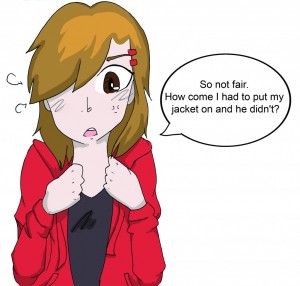
People express themselves through the way they dress just as they do through their speech. However, schools all over the country claim that dress codes are necessary to promote safety, prevent gang activity and “disruption to the educational process.” While those are very respectable points on why there should be a dress code, the rules are not always applied equally.
In the official MTHS Student Handbook, under the section ‘Dress Expectations’, it states that a student should not wear clothing with inappropriate slogans, clothing that can show undergarments, and clothing that exposes amount of skin that may cause a distraction is not permissible. It is expected that in a high school full of hormonal teenage boys, a female student showing too much skin is a distraction. This being said, should a girl have to go through the process of either not being allowed to return to class until they get a change of clothes or having to wear lost and found clothes, all because a male student might find himself distracted by extra skin?
The amount of rules that girls have to go through when choosing their outfit for the day is not even comparable to that of a guy. There are no specific requirements on how short someone can wear their clothes or the length of shirt sleeve, according to the Student Handbook, if it causes a distraction then it is not allowed.
These rules for not showing too much skin tend to single out and mostly affect the female student because they are most likely to be the ones wearing skirts, shorts, and dresses. The argument that girls will be a distraction to the learning environment because of the amount of skin they show is demeaning and a way to objectify girls and subject them to being sexual objects. This argument is saying that girls are nothing more than a distraction that need to be censored and constantly covered up because guys can’t handle their “raging hormones.“

Now what if the roles were reversed? There have been many of cases of male students wearing very short shorts for school spirit days and not even getting a second glance at. Another example is when boys “sag” their pants and display their undergarments yet they are still not put through the ridicule of having to change into lost and found pants because their pants are too low. Instead the student may get a verbal warning to pull their pants up but, since they bought two sizes too large, their pants will immediately return to their low position. They can wear muscle tees that expose their sides, which could also distract the other students, and completely get away with it.
There is also the argument that wearing clothes that show too much skin is just inappropriate for a school setting. If this is the case then there should be strict guidelines on what a student can and can’t wear. The current policy is very vague, so it is up to a teacher who would happen to see it and their standards for what is appropriate and what is not. The problem here isn’t necessarily how a clothing policy is a restriction on a student’s freedom of expression, but about how the clothing policy is unfairly targeted at the female population of the school. If the administration wants to choose what students wear, they must enforce the rules fairly and equally.
